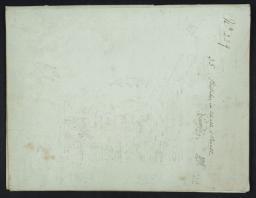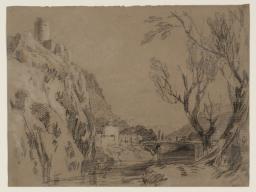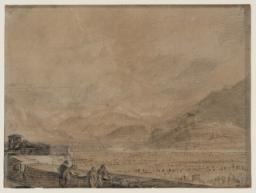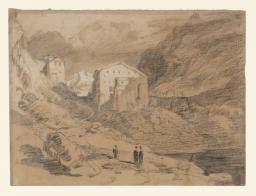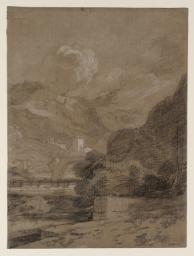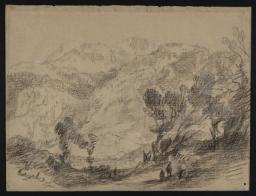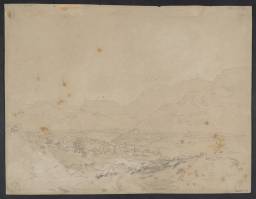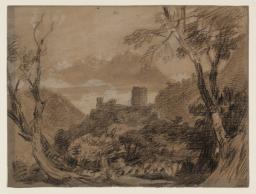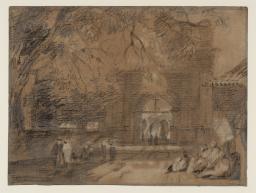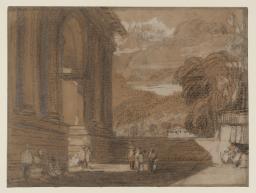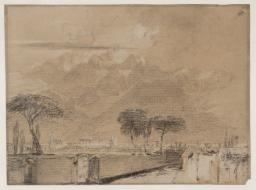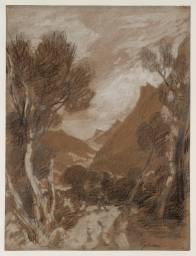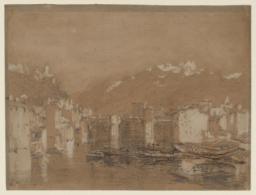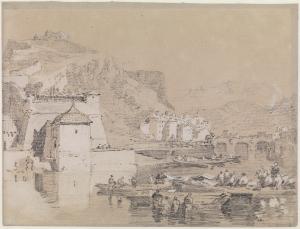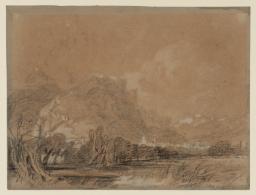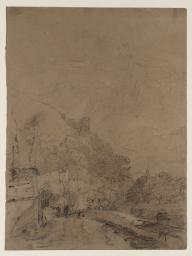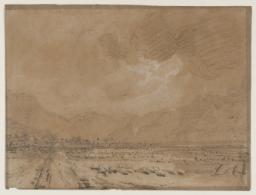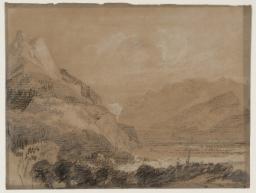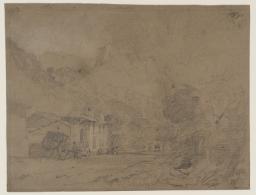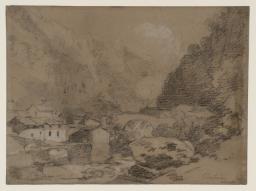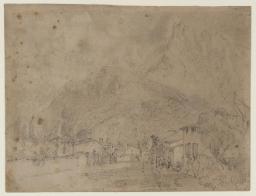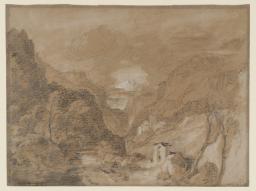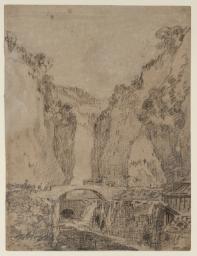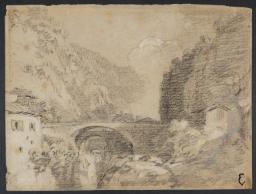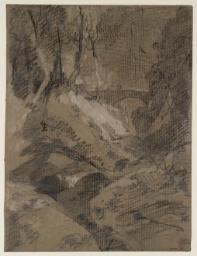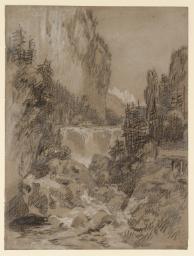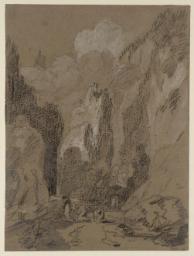Leaves probably from a dismembered sketchbook, of greyish-buff laid paper, made on a single-faced mould, various page sizes, made by Jean-Louis Delagarde at Papeteries du Marais, Seine et Marne, France, and watermarked ‘Papeterie du Marais’
Various sizes
‘Flyleaf’ (D04493; Turner Bequest LXXIV 1) of blue laid paper, made on a double-faced mould, by an unidentified maker, probably French, without watermark
Inscribed by the Executors of the Turner Bequest in ink ‘35 sketches in chalk & pencil’ and signed by Charles Turner in ink ‘C Turner’ and in pencil by John Prescott Knight and Charles Lock Eastlake in pencil ‘JPK and C.L.E.’
Various sizes
‘Flyleaf’ (D04493; Turner Bequest LXXIV 1) of blue laid paper, made on a double-faced mould, by an unidentified maker, probably French, without watermark
Inscribed by the Executors of the Turner Bequest in ink ‘35 sketches in chalk & pencil’ and signed by Charles Turner in ink ‘C Turner’ and in pencil by John Prescott Knight and Charles Lock Eastlake in pencil ‘JPK and C.L.E.’
Accepted by the nation as part of the Turner Bequest 1856
References
This large and varied group of drawings is usually said to have come from a sketchbook although they are first recorded mounted in an album, distributed for exhibition or kept loose in parcels. The subjects were drawn during Turner’s travels in France, Savoy and Switzerland in 1802, with particular concentrations around Grenoble and in the Chartreuse, in and near Aosta, at Martigny, in the St Bernard Pass and around Lakes Geneva and Brienz. Turner bought the sketchbook (if such it was) in Paris. The name ‘Grenoble’ seems to have originated in Finberg’s Inventory and is not written on any surviving early material. Presumably it was chosen because the drawings begin as Turner approached Grenoble from Lyons and include views of the city itself, where he spent three or four days.
Like the drawings in the larger St Gothard and Mont Blanc sketchbook (Tate D04590–D04643; D04645–D04648; D41390–D41391; Turner Bequest LXXV), the more elaborate among the Grenoble drawings translate scenery observed on the spot in smaller sketchbooks into a more considered pictorial language. However, they are distinct in technique and style, often drawn with great vigour and concentrating on mass and tone rather than colour. Most subjects are in landscape format but a few, thought by Nicholas Serota to be among the ‘most successful’,1 are upright. Among the many Turner scholars who have discussed these drawings, Andrew Wilton has remarked on the ‘extraordinary quantity of material’ contained in the series as a whole, adding that Turner’s choice of a mid-toned French paper was ‘perhaps an indication of the special status these drawings were to have for him’.2 While some subjects survive as quick pencil outlines, a few are repeated and many more worked up with black and white chalk or gouache. Gerald Wilkinson imagined Turner eagerly experimenting with new crayons ‘of far better quality than mere charcoal and chalk’, bought in Paris, ‘the home of Conté’.3 Although several drawings have touches of watercolour, the intention is usually to reconstruct or amend compositions in terms of light and shade, more varied local colour being superfluous to the design.
The use of monochrome media on a toned background progresses from Turner’s ‘Scottish Pencils’ drawn the previous year and probably from a longer history reaching back to drawings by Richard Wilson, especially his series of Italian scenes made for the Earl of Dartmouth in 1754; but the results are more varied and expressive. Finberg judged Turner’s handling ‘broad and firm [with] a conscious striving for massiveness, squareness, and stability of design’ that recalled the architectonic compositions of Nicolas Poussin and the Bolognese masters. This is to stress the classicism evident in subjects like Roman Aosta or Villeneuve, which must have served as substitutes for Italy or even for Rome itself which Turner was as yet unable to visit. But Turner’s methods respond as effectively and with greater immediacy to a tangle of fallen trees in the Chartreuse (D04531; Turner Bequest LXXIV 38) or the glaciers and forests at Grindelwald (D04537; Turner Bequest LXXIV 44). For Wilkinson, the handling varies between ‘extremes of violence and solemnity’.4 Wilton finds in the best of the drawings a ‘sophisticated pictorial structure’5 and the present writer has described them as ‘pictures in embryo’.6
Turner was the first to distribute these drawings, mounting about sixty of the most finished in an album with his selections from the St Gothard and Mont Blanc sketchbook. Visiting Turner in London on 22 November 1802, the painter Joseph Farington saw the drawings in something approaching the order of Turner’s itinerary and thus perhaps already in the album. His account of scenes of ‘Grenoble, Defile of the Grand & Petit Chartreuse ... abounding with romantic matter ... of Aost, – St. Bernard &c’ must refer specifically to Grenoble drawings. He described them as ‘slight on the spot, but touched up since many of them with liquid white, and black chalk’7 – implying that these revisions were made later, in batches as Turner travelled or back in the studio. The mounts or labels of the drawings were inscribed with their titles by Turner himself, often in a sort of phonetic French, probably based on commentaries provided by the guide hired by his travelling companion, Newbey Lowson. Together, drawings and labels formed a record of his tour and could be shown to clients, as a foretaste of the ‘sample studies’ which the artist and his dealer Thomas Griffith used in the 1840s to attract commissions for watercolours.
A number of finished works evolved from these drawings, for patrons whose initials are sometimes noted on the labels. For example ‘F’ on Turner’s label corresponding to the drawing of Grenoble Bridge with Mont Blanc in the distance (D04506; Turner Bequest LXXIV 14) denotes Walter Fawkes who made a wide choice of subjects from Turner’s album. However a later note in the Greenwich sketchbook (Tate D16721; Turner Bequest CII 1) suggests that this commission had been taken over by Fawkes’s friend Edward Swinburne, the ‘Ed’ cited on several labels. Despite this, a finished watercolour of Grenoble only seems to have materialised in 1824, for Charles Holford (Baltimore Museum of Art, Maryland),8 via intermediate colour studies (Tate D25515, D25491, D25469, D25490; Turner Bequest CCLXIII 391 (add), 368, 346, 367).
For Fawkes, Turner made a watercolour of Ringgenberg Castle on Lake Brienz dated 1809 (Taft Museum, Cincinnati, Ohio)9 based on the Grenoble drawing (D04539; Turner Bequest LXXIV 46). Sir William Pilkington, Fawkes’s relation by marriage, seems to have ordered the so-called ‘Scene in Savoy’ (Wolverhampton Art Gallery)10 based on several drawings (for example D04541, D04552; Turner Bequest LXXIV 48, 59) here tentatively identified as of Martigny. Other watercolours originating in this sketchbook (from D04497; Turner Bequest LXXIV 5) depict the Roman bridge at Villeneuve, one (private collection)11 dated 1813, first recorded in John Ruskin’s collection and another, later and more idealised (British Museum, London).12 Turner also made a colour study of Mount Emilius and Château d’Argent from above Villeneuve (Tate D04895; Turner Bequest LXXX B) from the drawing (D04500; Turner Bequest LXXIV 8) so may have been planning a finished version of this subject as well.
Besides independent watercolours, Turner essayed two small paintings from subjects in this series of drawings. An oil sketch of Grenoble from the River Drac (Tate N02988)13 was made, probably c.1803, from D04542; Turner Bequest LXXIV 49 (stamped ‘O’) while a more finished and romanticised picture (Tate N00465)14 can be sourced to various views of Martigny with the Castle of La Bâtiaz (for these see D04494; Turner Bequest LXXIV 2).
The last works to be based on Grenoble drawings were vignettes illustrating Samuel Rogers’s poem Italy (1830); However, Turner did not refer back to them as much as might perhaps be expected and Cecilia Powell has commented on his selective use of the 1802 material, and recourse to memory and imagination, when composing the vignettes.15 A vignette of the Hospice at the summit of the Great St Bernard Pass was taken from the Grenoble drawing (D04496; Turner Bequest LXXIV 4) via a watercolour study (Tate D27670; Turner Bequest CCLXXX 153). A lively street scene in Martigny, including the inn where Turner stayed, was worked up from two drawings (D04547, D04580; Turner Bequest LXXIV 54, 87) and a sketch of the cabriolet in which he had travelled from Paris (D40208) via the watercolour (Tate D27671; Turner Bequest CCLXXX 154). This last is evidence of the sense of place and experience of travel that still pervade the Grenoble series. The same cabriolet appears parked outside the post house at Voreppe, on the way to the Chartreuse (D04515; Turner Bequest LXXIV 22); roads, bridges and ferries are common motifs; clusters of drawings such as occur at Grenoble or Martigny indicate stopovers of several days; and the three figures who often appear, for example approaching the Hospice of St Bernard as light fades at the end of the day, might be Turner, Newbey Lowson and their guide. The weather conditions they experienced are vividly recalled, whether by raindrops on a drawing of Martigny (D04509; Turner Bequest LXXIV 16) or the white gouache indicating brilliant sunlight on buildings at Grenoble (D04507; Turner Bequest LXXIV 14a) or Vevey (D04535; Turner Bequest LXXIV 42).
Despite (or because of) its value as a travelogue, Turner’s alpine album did not long survive its accession with the Bequest and it was dismantled by Ruskin for exhibition. Now empty of drawings it survives today in the prints and drawings room at Tate Britain (see Technical notes, below). Some Grenoble drawings were chosen for display at Marlborough House from 1857 and, later, a much larger group for the National Gallery; Finberg listed them as LXXIV 2–44. More, LXXIV 51–60, were lent to the University Galleries, Oxford and three others, LXXIV 94–6, circulated in the touring Loan Collections. All were shown with titles given by Ruskin and/or written on the frames by the National Gallery curator Ralph Wornum, presumably based on Turner’s labels. Unfortunately, some of the titles were vague or generic, applicable to more than one drawing, and although Ruskin quoted several of them in his catalogue notes he kept no complete records of which went with which. Instead, Ruskin divided the labels into groups which he filed in blue paper wrappers, which survive with the Bequest. Wrappers named by Ruskin ‘Titles of Chartreuse Series’ and ‘Titles of Smaller Swiss Series’ clearly contain Grenoble labels. A third inscribed ‘4th Italian frame’ may hold a few others, although most seem to be subjects from St Gothard and Mont Blanc. Where possible, this catalogue attempts to rejoin the drawings with Turner’s labels, but the task is far from being completed.
In his early catalogue for the display of the Bequest at Marlborough House,16 Ruskin sought to justify the break-up of the album. His remarks are sometimes puzzling, or even contradictory. Despite Farington’s description of a sequence of subjects more or less corresponding to Turner’s itinerary in 1802, and the unlikelihood that Turner would ever part with such a precious resource, Ruskin claimed the album had been sold and bought back by the artist and ‘retains still its auction ticket’.17 This is not quite true as all that survives is an earlier lot number, probably from the sale at which Turner first bought the album, or it was acquired by some patron or friend who passed it on to him. According to Ruskin, the purchaser had mounted the drawings ‘in a more orderly fashion than, as far as I know, he [Turner] ever achieved in business of this kind’.18 But a few pages later in the same pamphlet, Ruskin says that they ‘were all out of order in the book, so that the real course of Turner’s journey cannot be known’.19 Moreover, the drawings had ‘sustained terrible injury already by friction in the massy volume, being in some cases nearly half effaced; so that it was absolutely necessary to arrange them in another manner’,20 for example ‘to form a little tour of Mont Blanc from Vevey to Grenoble’.21 Apparently unaware of Turner’s actual route, Ruskin was also unsure whether his tour had taken place in 180222 or 1803.23 Choosing ‘Sketches in Savoy and Piedmont’ for display, Ruskin was guided by aesthetic and technical considerations, and by what might be helpful for artists. In these respects, his comments cannot be bettered. He described the drawings as made
With very black, soft pencil, on dark tinted paper, touched with white. Of the highest value and interest ... all in complete chiaroscuro, and in his grandest manner. They are absolutely true to the places; no exaggeration is admitted anywhere or in any respect, and the composition, though in the highest degree learned, and exemplary of constructive principles of design, are obtained simply by selection, and alteration of forms, – and by the introduction either of clouds, figures, or entirely probable light and shade.
All are rapid and bold; some, slight and impetuous; but they cannot be too constantly studied, or carefully copied, by landscape students, since, whatever their haste, the conception is always realized; and the subject disciplined into a complete picture, balanced and supported from corner to corner, and concluded in all its pictorial elements.
Observe also that although these sketches give some of the painter’s first, strongest, and most enduring impressions of mountain scenery, and architecture of classical dignity, – their especial value to the general student is that they are in no respect distinctively Turnerian, but could only be known by their greater strength and precision from studies such as [Thomas] Gainsborough or Wilson might have made at the same spots; and they are just as useful to persons incapable of colouring, in giving them the joy of rightly treated shade, as to the advanced colourist in compelling him to reconsider the foundations of effect, which he is too often beguiled into forgetting.24
Elsewhere, Ruskin qualified his praise, noting the ‘very peculiar character’ of these drawings, ‘much more formal and complete’ than Turner’s usual studies from nature. Ruskin raised the possibility that they were ‘finished after returning home’, afterwards confirmed by his discovery of preliminary versions of some subjects, ‘mere outlines, each made on the spot in about three minutes’. Ruskin attributed their evolution to ‘some reference to the taste of the public, or of his patrons; perhaps, in some cases, to show beforehand the plan of some prepared picture’. Another possibility, in some cases, might be that Turner was instructing Lowson in aspects of drawing. Ruskin concluded that the ‘precise nature of these drawings’ was hard to define.25
Turning to the lesser Grenoble drawings, Ruskin was confronted by a bewildering variety of materials and styles. Having, as he thought, chosen the best for exhibition, he split the rest into batches of diminishing importance, the lowest of which equated to his category of ‘rubbish’. As well as the album, the Bequest was found to contain ‘thirty-five sketches in chalk & pencil’ in a pale blue wrapper, which the Executors numbered 229 in the Schedule and Finberg described as ‘page 1’ or the ‘flyleaf’ of the sketchbook (D04493; Turner Bequest LXXIV 1). As well as the flyleaf and the exhibited drawings, Finberg described twenty-two leaves, LXXIV 61–82, in a ‘parcel labelled by Mr. Ruskin – “M. 16. Leaves of S. 229. Laid down.” They have been mounted on cartridge by Mr. Ruskin.’ Evidently, Ruskin isolated these because they are mainly pencil outlines without chalks or gouache. A further parcel of eleven drawings, LXXIV 83–93, was ‘labelled by Mr. Ruskin – R. 277. Grenoble series. Inferior drawings.’
These two batches may or may not correspond to the thirty-five sketches described on the wrapper and the position is complicated by the existence of a further twenty-seven leaves stamped LXXIV A–Z and b. Of these, nineteen match leaves numbered by Finberg, leaving eight as additions to his catalogue of which one, stamped LXXIV C, does not belong to Grenoble at all (see Technical notes below). In a final twist, five leaves numbered by Finberg are apparently missing although these too can probably be located among the lettered works. Overall, the situation is perplexing and it is futile to try to reconstruct the original sequence which (much as one might wish Ruskin and Wornum had left well alone) was first dismantled by Turner himself.
Fascinating as this series of drawings is, their content, varied media and finish, and subsequent dispersal raise as many questions as they answer. Not all their subjects can be positively identified. Some are generic in composition as are many of Turner’s titles. While these doubtless reflect on his still-evolving response to unfamiliar scenery, they make it difficult to distinguish individual subjects or places, and the problem is compounded by Ruskin’s removal of the artist’s labels. Ruskin’s identifications have been superseded by the work of David Hill, Cecilia Powell and the present writer while Roland Courtot has kindly provided comments and corrections on the topography of Grenoble and Jean-Marc Roget on that of the Chartreuse, from local knowledge. However, some subjects remain elusive, especially among what Turner and Ruskin regarded as lesser drawings from the series. This catalogue should not be regarded as definitive but rather as a work in progress.
Technical notes
The lists are given here, verbatim, with Turner’s spelling:
3 Vale near St Martin
7 Fall of the Riquenbach
Bonneville Done Grenoble to go Harley St
Salenche T Wright Esq 27½ x 12½ 20G
4 Source of the Arveron
6 On the ?Aran
Scot Loch Long Fyne
Loch Lomond with Cloud Sir William Pilkington Bart
Fort Dauphin
Gt Chatreuse
Entrance of Petit Chatreuse
Grenoble
Savoy Mill near the Convent
5 Bridges Vale de ?Arve
Ville de Salle
2 Lake of Brientz Mr ?Fawkes
7 Fall of the Riquenbach
Bonneville Done Grenoble to go Harley St
Salenche T Wright Esq 27½ x 12½ 20G
4 Source of the Arveron
6 On the ?Aran
Scot Loch Long Fyne
Loch Lomond with Cloud Sir William Pilkington Bart
Fort Dauphin
Gt Chatreuse
Entrance of Petit Chatreuse
Grenoble
Savoy Mill near the Convent
5 Bridges Vale de ?Arve
Ville de Salle
2 Lake of Brientz Mr ?Fawkes
1 Salenche
2 Loch Fyne
3 Loch Lomond March 1815
7 Vevay
Gd Chatreuse (deleted)
Entrance of Petit Do (deleted)
4 Grenoble
5 Mill near the Convent
6 Ville de Salle
Storm
Calm over ?Land/Sand
2 Loch Fyne
3 Loch Lomond March 1815
7 Vevay
Gd Chatreuse (deleted)
Entrance of Petit Do (deleted)
4 Grenoble
5 Mill near the Convent
6 Ville de Salle
Storm
Calm over ?Land/Sand
How to cite
David Blayney Brown, ‘Grenoble Sketchbook 1802’, sketchbook, March 2012, in David Blayney Brown (ed.), J.M.W. Turner: Sketchbooks, Drawings and Watercolours, Tate Research Publication, August 2014, https://www

